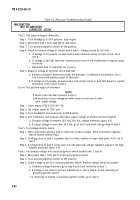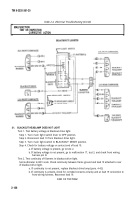TM-9-2320-361-20 - Page 184 of 1207
TM 9-2320-361-20
Table 2-4. Electrical Troubleshooting (Contd).
MALFUNCTION
TEST OR lNSPECTlON
CORRECTIVE ACTION
15. BATTERIES NOT CHARGING PROPERLY (GENERATOR IN YELLOW OR RIGHT-HAND RED)
Test 25 amp charging system (malfunction 16, tests 1 and 2).
END OF TESTING!
16. BATTERIES RUN DOWN IN OPERATION
NOTE
If STE/ICE is available, perform NG50 - charging circuit tests
(chapter 2, section VII).
Test 1. Check for loose or missing alternator belts.
a. Adjust loose belts (para. 4-2).
b. Replace missing belts (para. 4-2).
Test 2. Test charging voltage across batteries.
Step 1.
Step 2.
Step 3.
Step 4.
Step 5.
Step 6.
Open door of battery compartment. Loosen two thumbscrews and slide batteries onto
running board.
Use multimeter to check for battery voltage.
Start engine (TM 9-2320-361-10).
Set engine speed at 1200 rpm.
Turn vehicle headlights and accessories to ON position.
Use multimeter to check battery voltage. Charging voltage on batteries should be
28.0 ± 0.2 Vdc.
a.
b.
c.
d.
If charging voltage is between 24.0 to 26.0 Vdc, 25 amp charging system is not to be
repaired. Replace 25 amp charging system with 60 amp alternator conversion
kit 11647745 (para. 4-3).
If charging voltage is between 26.0 to 30.0 Vdc, remove plug from top or side of
regulator. Turn voltage adjusting reostat until charging voltage across battery is
28.0 ± 0.2 Vdc.
If voltage cannot be adjusted, replace 25 amp charging system with 60 amp conversion
kit 11647745 (para. 4-3).
If charging voltage can be adjusted to 28.0 ± 0.2 Vdc, go to step 7.
2-99
Back to Top




















